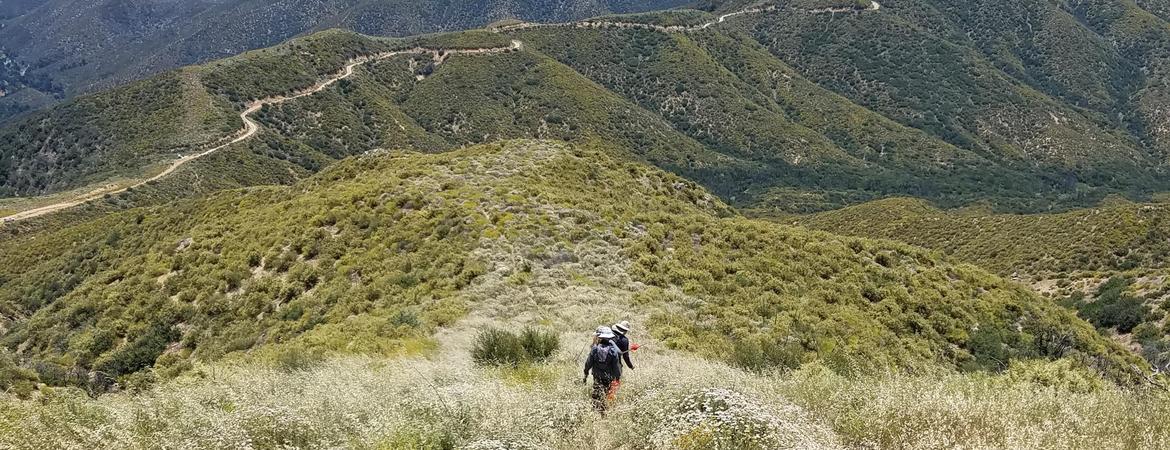
The worst fire impacts this year are predicted to hit Northern California’s higher elevation forests and Southern California’s chaparral-clad mountainous National Forest lands. To aid recovery, UC Riverside ecologists are collaborating with the US Forest Service to target these spots with new post-fire ecological restoration strategies.
Wildfires are becoming more ferocious, damaging, and expansive in the West. California just weathered its worst two years ever in terms of total acres burned. And conditions are no better this year, with the Golden State having its driest winter on record.
“On a national scale, there's no ‘fire season’ anymore. It's all year round,” said Janet Franklin, distinguished professor and biogeographer in UCR’s Department of Botany and Plant Sciences.
Looking ahead this year, a continuing drought is expected to have its greatest fire impacts in the higher elevation pine forests in Northern California, the Sierra Nevada, and the mountainous national forests in Southern California.
California’s conifer forests are becoming drier from drought exacerbated by climate change as they also continue to accumulate highly combustible dead wood and other fire fuels, thanks to more than a century of fire suppression efforts, Franklin said. It is a recipe for hotter and larger fires that burn into the canopies instead of just moving along the ground. Climate change is also producing “extreme weather” including untimely lightning storms that spark wildfires.
Counterintuitively, don’t expect the continuing drought to increase the risk of wildfires in shrubby chaparral landscapes that flare up in and near urban and suburban Southern California communities, said Loralee Larios, an assistant professor of botany and plant sciences. Chaparral landscapes naturally dry up every summer and tend to catch fire when sparked by human activity on windy days, she said.
“Normally, chaparral ecosystems are used to drought. They're used to fires, and we usually think of them as very resilient systems that can just bounce right back,” Larios said.
Unfortunately, she added, chaparral often fail to recover when fires occur on the same land repeatedly, when droughts follow the fires, or as they become degraded by invasive grasses and other plants.
UCR ecologists are collaborating with the US Forest Service to find ways for healthier ecosystems to rise from the ashes. One group is developing strategies for the restoration of chaparral shrublands so that these biodiversity hotspots rebound with native plants after fire. Another is tracking the progress of burned higher elevation conifer forests replanted with more drought-tolerant pine species that normally grow at lower, drier elevations.
These two collaborations help meet an increasing need for applied science to guide federal fire restoration efforts while at the same time answering important academic questions, said Nicole Molinari, an ecologist with the Forest Service.
Chaparral landscapes are biodiversity hotspots with diverse plant species like manzanitas and chamise providing cover for an array of reptiles, birds, and mammals, though their ecological value, say UCR scientists, is underappreciated.
Working on earth scarred by the 2013 Powerhouse Fire in the Angeles National Forest west of Palmdale, Larios’ team is unraveling the interplay between drought, pre-fire invasive plant abundance, and fire history to determine what circumstances best allow for the return of native plant communities.
They began with plant surveys in 2019 and they have since planted some 1,000 seedings of native shrubs, including California sagebrush, white sage, golden current, and the heartleaf keckiella, and are tracking the re-establishment of such vegetation. They recently expanded their plantings to the area of the nearby Lake Fire that occurred in 2020.
The knowledge gained is extremely important to Forest Service as it decides when, where, and how to embark on chaparral restoration projects, Molinari said.
Marko Spasojevic, an assistant professor in the Department of Evolution, Ecology, and Organismal Biology, is also collaborating with the Forest Service. He is overseeing the progress of drought-tolerant pine species planted in the upper elevation conifer areas that also burned in the Powerhouse Fire. These species, including Bigcone Douglas firs and gray pines, grow in the same forest but normally at lower and drier elevations. The hope is that replanting the more tolerant species will result in more resilient forests.
Spasojevic is also finding that more drought-tolerant tree species appear to be moving to higher elevations on their own. The evidence is on the slopes near Idyllwild, where a woodland-chaparral community of black oaks and manzanita shrubs transition into a pine forest. Here, more drought-tolerant oaks make up about 45% of the canopy. But about 75% of seedings taking root on the ground are baby oak trees, and just a few pine species seedlings are to be found.
“The pines are giving up ground to the black oaks,” Spasojevic said.
The oaks can withstand much hotter fires, with their charred remains sprouting new growth soon afterward, although the oaks are also susceptible to an invasive beetle, Spasojevic said.
Still, these forests, pushed by climate, are “primed for change,” he said.
Header image: UCR undergraduates sampling chaparral post-fire recovery in the Angeles National Forest Powerhouse Fire burn scar in the summer of 2019 (Sunny Saroa).



